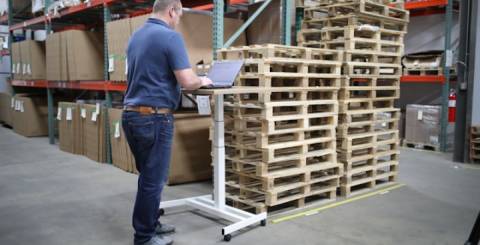How Do You Organize Warehouse Shelves?

Did you know that inefficient organization in warehouses can lead to businesses losing up to 30% of their daily productivity? By optimizing the way you organize your warehouse shelves, you can significantly improve operational efficiency and streamline your inventory management processes.
From categorizing inventory items to incorporating advanced technology solutions, there are various strategies that can help you achieve a well-organized and productive warehouse environment. One effective step is investing in quality shelving systems from trusted suppliers like Unirack. So, how exactly can you ensure your warehouse shelves are organized for maximum efficiency and productivity?
Categorizing Inventory Items
When organizing warehouse shelves, categorize inventory items based on their type and frequency of use. This approach optimizes efficiency and streamlines the retrieval process. Begin by separating items into distinct categories such as electronics, tools, or office supplies. Within each category, further classify items based on their frequency of use. Place high-demand products in easily accessible areas to minimize picking time. Utilize storage solutions like bins, shelves, and racks to keep items organized and maximize space utilization.
Consider implementing a system where frequently used items are placed closer to the packing and shipping area, while slower-moving products can be stored further away. This strategy reduces unnecessary movement within the warehouse and enhances overall productivity. Regularly review and adjust your categorization system to accommodate changes in inventory levels and demand patterns. By categorizing inventory items thoughtfully, you create a well-organized and efficient warehouse environment that boosts productivity and minimizes operational hiccups.
Implementing Efficient Labeling Systems
To enhance the efficiency of your warehouse organization further, consider implementing efficient labeling systems that facilitate easy identification. Proper labeling can streamline picking, packing, and restocking processes, ultimately saving time and reducing errors.
Here are some tips to help you set up effective labeling systems:
1. Clear and Consistent Labels: Ensure that labels are easy to read from a distance and use a consistent format throughout the warehouse for quick recognition.
2. Barcoding Systems: Implement barcoding systems to enable quick scanning and tracking of items, enhancing inventory management and reducing manual errors.
3. Location-Based Labels: Use location-based labels to indicate where items should be stored, making it easier for employees to find and return items to their designated spots.
4. Color-Coding: Consider using color-coded labels to visually categorize different types of products or designate priority levels, aiding in faster decision-making and organization.
Utilizing Vertical Storage Solutions
Consider maximizing your warehouse space by utilizing vertical storage solutions that optimize storage capacity and improve accessibility. Vertical storage solutions involve utilizing the height of your warehouse, not just the floor space. By installing tall shelving units, vertical carousels, or mezzanine platforms, you can efficiently store more inventory without expanding your warehouse's footprint.
Vertical storage solutions can help you make the most of unused overhead space. By organizing products vertically, you can access items more easily using forklifts or order pickers. This method also reduces the need for excessive bending or reaching for items, making the picking process more ergonomic and efficient.
Implementing vertical storage can also enhance inventory management by providing clear visibility of products and ensuring better rotation practices. By organizing items based on their demand or expiration dates, you can minimize the risk of stockouts and reduce the likelihood of obsolete inventory.
Incorporating vertical storage solutions into your warehouse layout can lead to a more organized, space-efficient, and productive operation.
Maximizing Space With Smart Shelving Layouts
Maximize your warehouse space efficiently by strategically organizing your shelves with smart layouts. To make the most of your storage area, consider the following tips:
1. Utilize vertical space: Install tall shelving units to take advantage of the height of your warehouse. This allows you to store more items without taking up additional floor space.
2. Implement bin locations: Assign specific locations for different types of products to create a systematic organization system. This makes it easier for employees to locate items quickly.
3. Use adjustable shelves: Opt for shelves that can be easily adjusted to accommodate items of various sizes. This flexibility ensures you can maximize the space available based on your current inventory.
4. Consider flow patterns: Arrange shelves in a way that promotes efficient movement within the warehouse. Place frequently accessed items closer to the shipping area to streamline operations.
Incorporating Technology for Inventory Tracking
Incorporate technology for efficient inventory tracking in your warehouse to streamline operations and improve accuracy. Implementing a barcode system can help you track items from the moment they arrive at the warehouse to when they're shipped out. By scanning barcodes, you can update inventory levels in real-time, reducing the risk of stockouts or overstock situations.
RFID technology is another option that allows for automated tracking of inventory as it moves throughout the warehouse, providing detailed insights into item locations and movement patterns.
Utilizing a warehouse management system (WMS) can further enhance your inventory tracking capabilities. A WMS can help you organize inventory, optimize picking routes, and generate reports to identify trends and improve inventory management strategies. Additionally, integrating your WMS with other systems, such as your accounting software or CRM, can streamline operations and improve overall efficiency.
How Can I Optimize Picking Routes in My Warehouse to Increase Efficiency?
To optimize picking routes in your warehouse and boost efficiency, streamline paths, group items logically, and minimize travel distances. Utilize software for route planning, analyze data for improvements, and train staff on efficient picking strategies to increase productivity.
What Are the Best Practices for Managing Inventory Turnover and Reducing Dead Stock?
To manage inventory turnover and reduce dead stock, ensure accurate forecasting, implement a first-in, first-out system, conduct regular audits, and optimize storage layout. By following these best practices, you can enhance efficiency and profitability.
How Can I Ensure the Safety of My Warehouse Staff When Working With Tall Shelves and Vertical Storage Solutions?
To keep your warehouse staff safe around tall shelves and vertical storage solutions, ensure they receive proper training on equipment use and safety procedures. Regularly inspect shelves for stability and implement clear signage for hazards.
Are There Any Regulations or Guidelines I Need to Follow When Organizing Hazardous Materials in the Warehouse?
When organizing hazardous materials in the warehouse, follow regulations and guidelines to ensure safety. Properly label, store, and handle these items. Implement training programs for staff and have emergency response procedures in place.
What Are Some Strategies for Dealing With Seasonal Fluctuations in Inventory and Storage Needs?
To handle seasonal fluctuations in inventory and storage, assess historical data, forecast trends, and adjust shelving layouts accordingly. Utilize flexible storage solutions like stackable bins and adjustable shelves to accommodate changing needs efficiently.
Similar Articles
Good leadership is a feature of such a person that they think of the whole team and not only themselves. Leadership is your behaviour, not your status by title.
In the world of civil construction, a small mistake can have a big impact. Whether it’s delays, budget overruns, or safety issues, the costs of poor staffing are often overlooked until it’s too late.
Learn how to choose winning products for your dropshipping website with smart research, trend analysis, and testing tips for better profits.
In today’s fast-growing lighting industry, LED strip lights have become one of the most popular solutions for modern lighting design.
Discover how partnering with a software developer recruitment agency can prevent burnout in development teams and enhance project sustainability.
Learn how corporate event catering boosts image, fosters networking, reduces stress, and creates memorable experiences at professional gatherings.
Discover essential commercial HVAC maintenance strategies to cut costs, boost efficiency, and ensure comfort for employees and customers.
Maximize your corporate mentoring program's impact. Discover best practices for strategic implementation to foster growth and development.
Strong bookkeeping turns financial chaos into clarity, guiding smarter decisions, ensuring compliance, and building long-term business stability.









